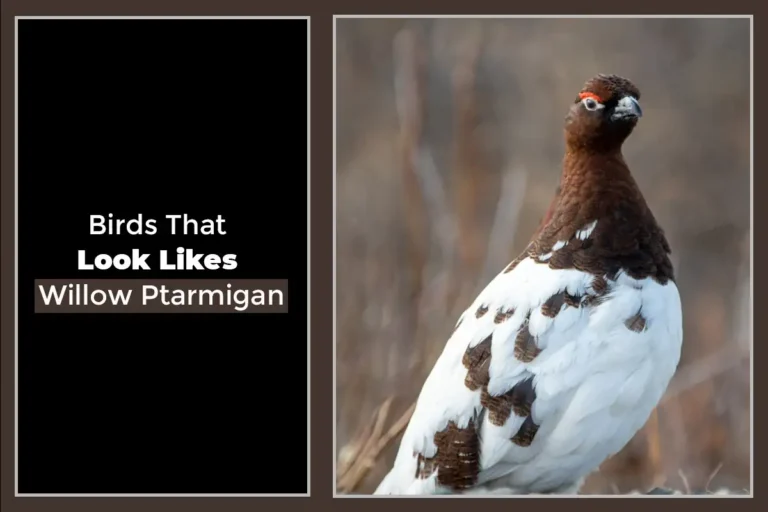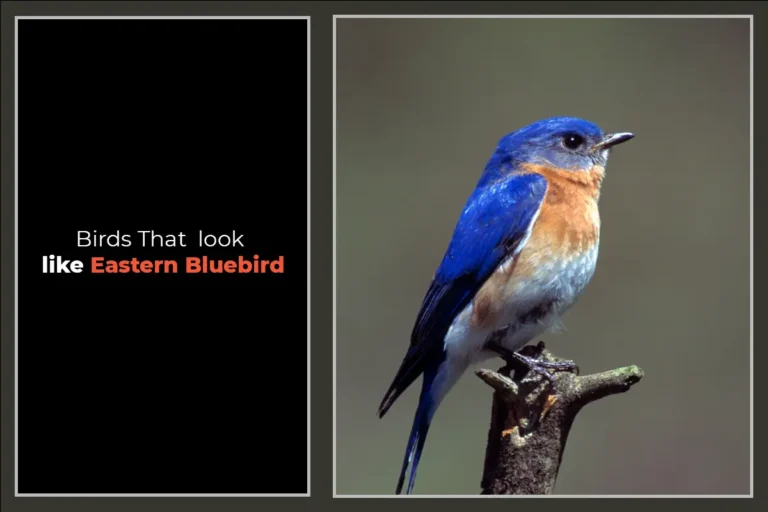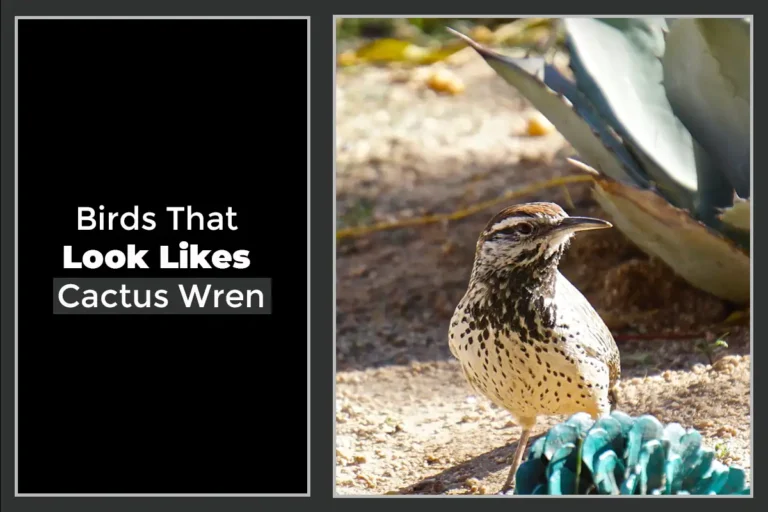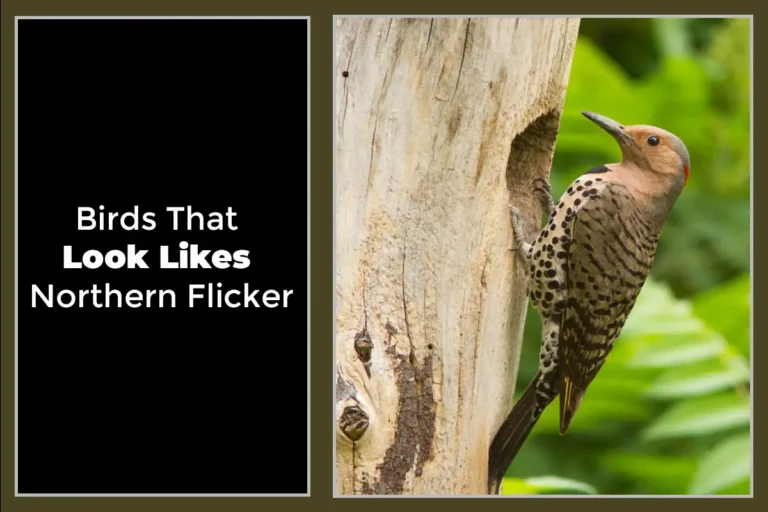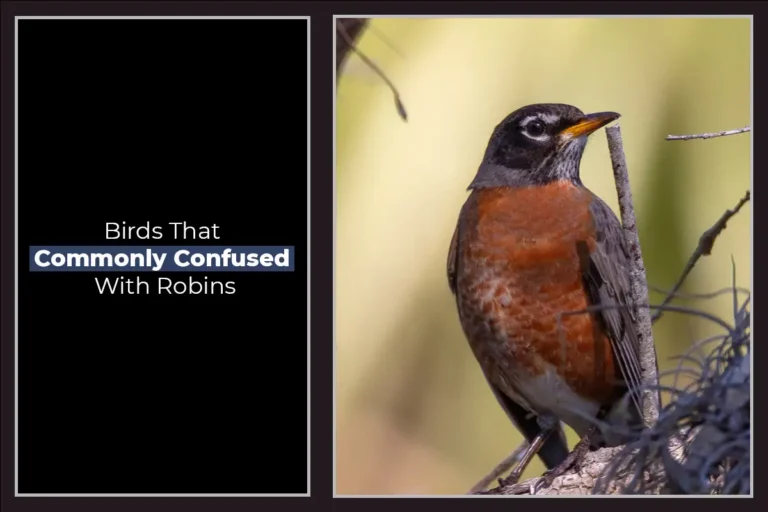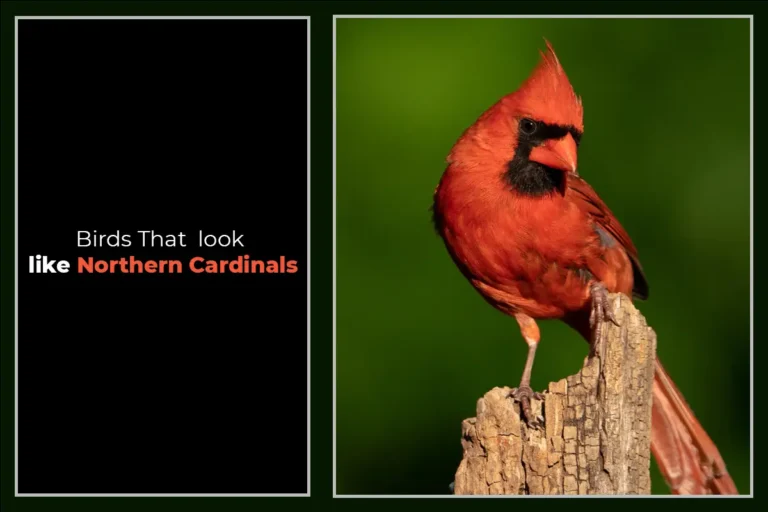9 Birds That Look Like California Quail
At first glance, that bird foraging along the chaparral hillside looks similar to the classic California quail – round body, topknot head feather, rich brown and gray plumage. But upon closer inspection, something seems…off. The markings don’t match perfectly.
This quail imposter lacks the Cali quail’s trademark black-and-white face pattern. So, what gives? Turns out, several species of birds closely resemble the Golden State’s beloved gamebird. Even some grouse boast crown feathers or coloration akin to California quail.
In this article, we’ll cover 9 birds that could easily be mistaken for California quail. I’ll highlight their key physical similarities as well as the subtle (or sometimes not-so-subtle) differences that set them apart. Consider it your guide to identifying quail phonies!
Looking for more articles about similar birds:
Common Differences Between Quail Family
Here is a table comparing California quail to other quail species and their common differences:
| Quail Species | Common Differences from California Quail |
|---|---|
| Mountain Quail | Mountain-dwelling habitat, smaller size and more rotund body, longer beak, white speckling |
| Scaled Quail | Prefers more arid climates, lacks top knot plume, has no black face markings, smaller legs and feet |
| Gambel’s Quail | Smaller size, teardrop-shaped top knot scales instead of blocky, black cheek patches outlined in white |
| Montezuma Quail | Tropical distribution, boldly patterned mottled plumage with no scales, limited U.S. range |
| Northern Bobwhite | Feathers lack scaled pattern, black and white face stripe instead of solid black, lack head plume |
01. Mountain Quail
The mountain quail (Oreortyx pictus) is a plump upland game bird that resides in the mountainous regions of the western United States.

With its scaly plumage, forward-curling top knot, and loud vocalizations, this bird mirrors the California quail in size, markings, and mannerisms.
Characteristics
- Plumage: Gray, brown, and white scaly markings on the body. The male has a black and white head plume.
- Size: 10-11 inches long.
- Habitat: Coniferous forests, woodlands, brushy areas.
- Range: Cascades and Sierra Nevada mountains.
Similarities
- Scaly body plumage pattern
- Forward-curling top knot plume
- Lives in coveys during non-breeding season
- Loud vocalizations
Differences
- Mountain-dwelling habitat
- Shorter tail and toes
- Smaller size and more rotund body shape
- White speckling on plumage
- Longer beak
02. Scaled Quail
The scaled quail (Callipepla squamata) is named for its distinctive scalloped gray, brown, and white plumage.

This desert-dwelling bird bears a strong resemblance to California quails in size, shape, markings, and behavior.
Characteristics
- Plumage: Gray and brown feathers with white scaly markings. A light streak on the throat.
- Size: 9-11 inches long. Squat, short-tailed body shape.
- Habitat: Deserts, plains, and brushlands of the southwestern U.S.
- Range: Colorado, Arizona, New Mexico, western Texas
Similarities
- Scaled body plumage pattern
- Crested head
- Gregarious in large coveys
- Reluctant fliers
- Nest on ground
Differences
- Prefers more arid climates
- Lacks top knot plume
- No black face markings
- Smaller legs and feet
03. Gambel’s Quail
Gambel’s quail (Callipepla gambelii) is a small upland game bird marked by teardrop-shaped top knot and intricate scaling on its body feathers.
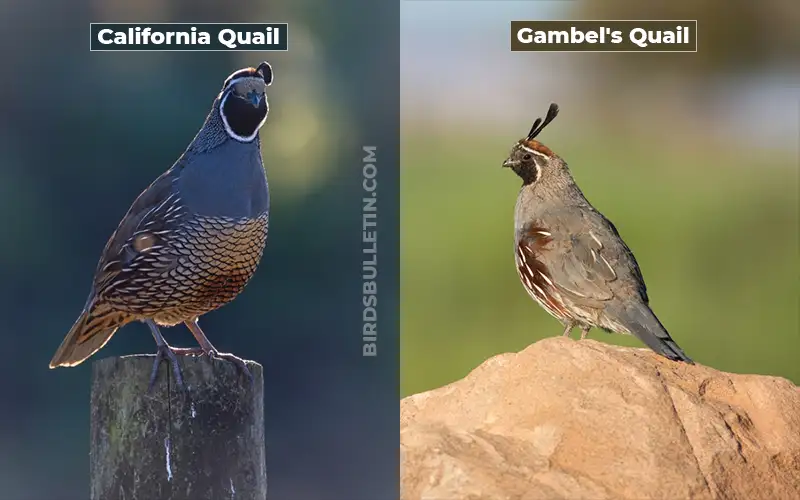
In terms of distribution and physique, this species shows many commonalities with California quail.
Characteristics
- Plumage: Gray and brown feathers with white teardrop-shaped scales. Black face outline.
- Size: 8-11 inches long. Short tail and legs.
- Habitat: Deserts, plains, foothills, chaparral
- Range: American Southwest and Mexico
Similarities
- Scalloped brown body plumage
- Forward leaning top knot
- Sociable birds that live in coveys
- Nest and feed on the ground
- Reluctant, short-burst fliers
Differences
- Smaller size
- Found in more arid climates
- Teardrop-shaped scales versus blocky scales
- Black cheek patches outlined in white
- The rosy tan coloration on the wings
04. Montezuma Quail
The Montezuma quail (Cyrtonyx montezumae) is a secretive New World quail bearing mottled markings, a short black face plume, and outward similarities with California quail anatomy.
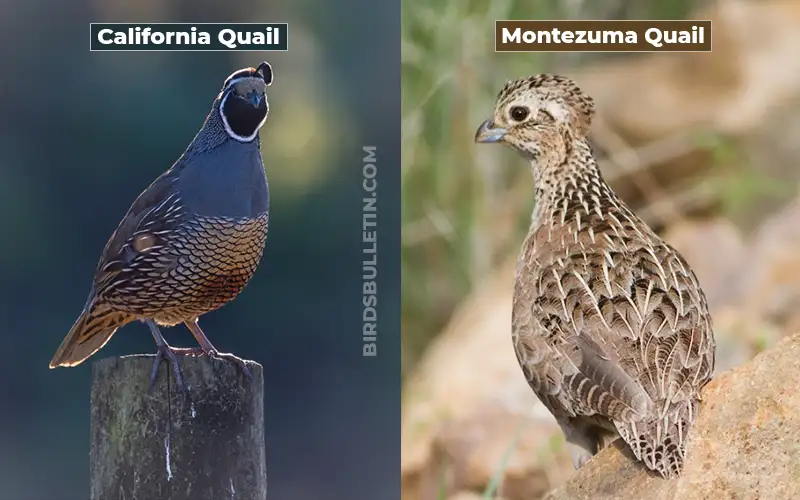
However, genetic analysis shows this species belongs to a separate genus.
Characteristics
- Plumage: Gray, brown, black mottled body with white spots. Black face plume projects forward.
- Size: 10 inches long. Short, rounded wings.
- Habitat: Pine-oak forests of Mexico and the Southwestern U.S.
- Range: Mexico and southern Arizona/New Mexico
Similarities
- Stocky body shape
- Black facial plume structure
- Terrestrial lifestyle
- Sociable, travel in coveys
Differences
- Tropical distribution
- Boldly-patterned, mottled plumage
- No scaled markings
- Different genus/not closely related
- Limited U.S. range
05. Northern Bobwhite
The northern bobwhite (Colinus virginianus) is a popular game bird known for its whistling call.
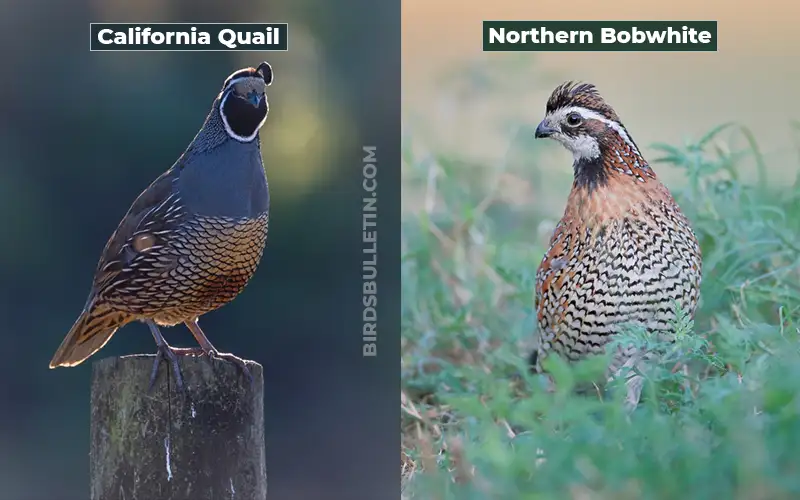
Despite lacking scales, this quail mirrors the California quail in size, form, behavior, and habitat preferences across many areas of eastern North America.
Characteristics
- Plumage: Buff, brown, black, and white barred/mottled patterns.
- Size: 6-10 inches long. Round, chunky body profile.
- Habitat: Grasslands, agricultural areas, brushy fields.
- Range: Eastern half of the U.S.
Similarities
- Rotund body shape and stance
- Terrestrial lifestyle
- Forms large winter coveys
- Nest and feed on the ground
- Reluctant fliers over short distances
Differences
- Feathers lack a scaled pattern
- Black and white face stripe
- No head plume
- Found east of the Rocky Mountains
- More northern distribution
06. Ruffed Grouse
The ruffed grouse (Bonasa umbellus) is a popular game bird known for spring courtship displays.

Despite lacking quail classification, this grouse mirrors California quails in size, habitat preferences, and behavior across much of eastern North America.
Characteristics
- Plumage: Brown, black, gray, white mottled plumage. Ruffs on the sides of the neck.
- Size: 15-19 inches long. Chicken-like in profile.
- Habitat: Woodlands, aspen stands, brushy areas.
- Range: Canada and the eastern U.S.
Similarities
- Ground-dwelling lifestyle
- Feeds on seeds, fruits, and greens
- Forms covey in fall/winter
- Short, fast burst flight
- Nest and roost on the ground
Differences
- Significantly larger
- No scaled plumage
- Fan-shaped tail
- The male has ruffs on his neck
- More northern and eastern range
07. Spruce Grouse
The spruce grouse (Falcipennis canadensis) is an elusive, chicken-like game bird that resides in coniferous forests.

Despite its distinct classification, this grouse shows some similarities to California quails in size, markings, and habitat preferences.
Characteristics
- Plumage: Gray and brown barred plumage. Black and white mottled throat.
- Size: 15-17 inches long. Round body shape.
- Habitat: High-elevation conifer and spruce woodlands.
- Range: Canada and Alaska; isolated mountain ranges in the western U.S.
- Call: Soft clucks and whines.
Similarities
- Ground-dwelling lifestyle
- Feeds on greens, seeds, berries
- Nest and roost on the forest floor
- Reluctant, short flight distances
Differences
- Significantly larger size
- No scalloped plumage
- Black and white speckled throat
- Found in boreal and montane forests
- More northern distribution
08. Chukar
The chukar (Alectoris chukar) is a Eurasian upland game bird introduced to parts of North America. Despite its exotic origins, this bird bears a surprising resemblance to California quails in size, markings, and behavior.

However, the two species are not closely related.
Characteristics
- Plumage: Pale brown and gray colors. Black and white face stripe. White throat bounded by the black collar.
- Size: 14-16 inches long. Plump body, short neck.
- Habitat: Arid hills, mountain slopes, rocky outcrops.
- Range: Introduced to the western U.S. and Canada. Native to Eurasia.
Similarities
- Ground-dwelling terrestrial lifestyle
- Rotund body shape and stance
- Feeds on a variety of seeds and greens
- Forms large coveys in winter
Differences
- Originally from Eurasia
- No scales on plumage
- Black and white facial stripe
- The grayer coloration on the body
09. Gray Partridge
The gray partridge (Perdix perdix) is an introduced Eurasian game bird marked by cryptic gray and brown plumage.

In spite of its exotic origins, this species occupies a similar niche to California quails across many areas of North America.
Characteristics
- Plumage: Brown and gray cryptic markings. Orange face patch. Teardrop-shaped black belly patch.
- Size: 12-14 inches long. Plump body with, a short tail.
- Habitat: Farmlands, fields, grasslands.
- Range: Introduced to Canada and northern U.S. Native to Europe/Asia.
Similarities
- Ground-dwelling terrestrial lifestyle
- Feeds on seeds, greens, grains
- Forms covey in fall and winter
- Nests and roosts on the ground
Differences
- Originally from Eurasia
- No scales or head plume
- Cryptic gray/brown plumage
- More northern distribution
- Associated with agricultural areas
Parting Word
The California quail stands out with its teardrop crown and scaly markings. However, several other ground-dwelling birds share physical qualities and behavioral traits that allow them to fill similar niches across various North American habitats.
From forest grouse species to desert-adapted Gambel’s quails and introduced game birds, numerous species mirror the iconic California quail to some degree. Familiarizing yourself with these look-alike species will be useful for identification purposes across much of the western United States.


